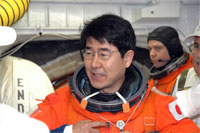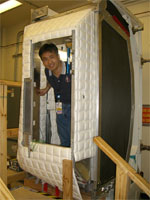JAXA Astronaut Activity Report, February 2008
Last Updated: April 21, 2008
This is JAXA's Japanese astronaut primary activity report for February 2008.
International Space Station (ISS) Expedition Operations Training in Russia
Astronauts Koichi Wakata and Soichi Noguchi participated in an International Space Station (ISS) expedition operations training program held at the Gagarin Cosmonaut Training Center (GCTC) in Russia.
They attended lectures and used simulators to learn the life support system, the thermal control system, and the communication systems on the Zarya and Zvezda modules and the Pirs docking compartment that constitute the Russian Segment of the ISS.
TCDT before the STS-123 mission

Astronaut Doi during TCDT(Image credit: NASA)
The STS-123 (1J/A) mission launched on March 11, 2008 (EDT) and completed its nearly 16-day mission on March 26, 2008 (EDT).
In February, astronaut Takao Doi and other STS-123 crew members participated in the Terminal Countdown Demonstration Test (TCDT) at NASA Kennedy Space Center (KSC), which was their last extensive training before the mission.
TCDT is a rehearsal at the launch pad in which the mission crew and ground team review and drill the pre-launch activities to acquaint themselves with the countdown procedures.
- STS-123(1J/A) Mission
NASA-JAXA Joint Multi-Segment Training (JMST)
Astronaut Hoshide and his fellow STS-124 (1J) Mission crew members participated in Joint Multi-Segment Training (JMST) that simulated mission-specific operations and communication procedures that are planned for the mission.
During JMST, the astronauts simulated their respective tasks of the Extravehicular Activities (EVAs) scheduled during the STS-124 Mission. Astronaut Akihiko Hoshide simulated robotic operations using simulators of the Space Station Remote Manipulator System (SSRMS) together with astronaut Karen Nyberg to assist the EVA.
- STS-124 (1J) Mission
Checking ISS crew personal cabin

Astronaut Wakata checking an ISS crew personal cabin
Astronaut Wakata checked the structure of an ISS crew personal cabin, in which a crew member will sleep during his/her stay aboard the ISS, using its mockup. The cabins will be launched aboard the space shuttle on the missions following the STS-126 (ULF2) mission, in preparation for having six crew members on the ISS.
The ISS crew personal cabin provides noise insulation for privacy and comfortable sleep. It has lighting and air-conditioning fans, as well as a speaker for emergency warning. It is the same in size as an International Standard Payload Rack (ISPR) so that it can be installed in the ISS modules in the same manner as an ISPR.



